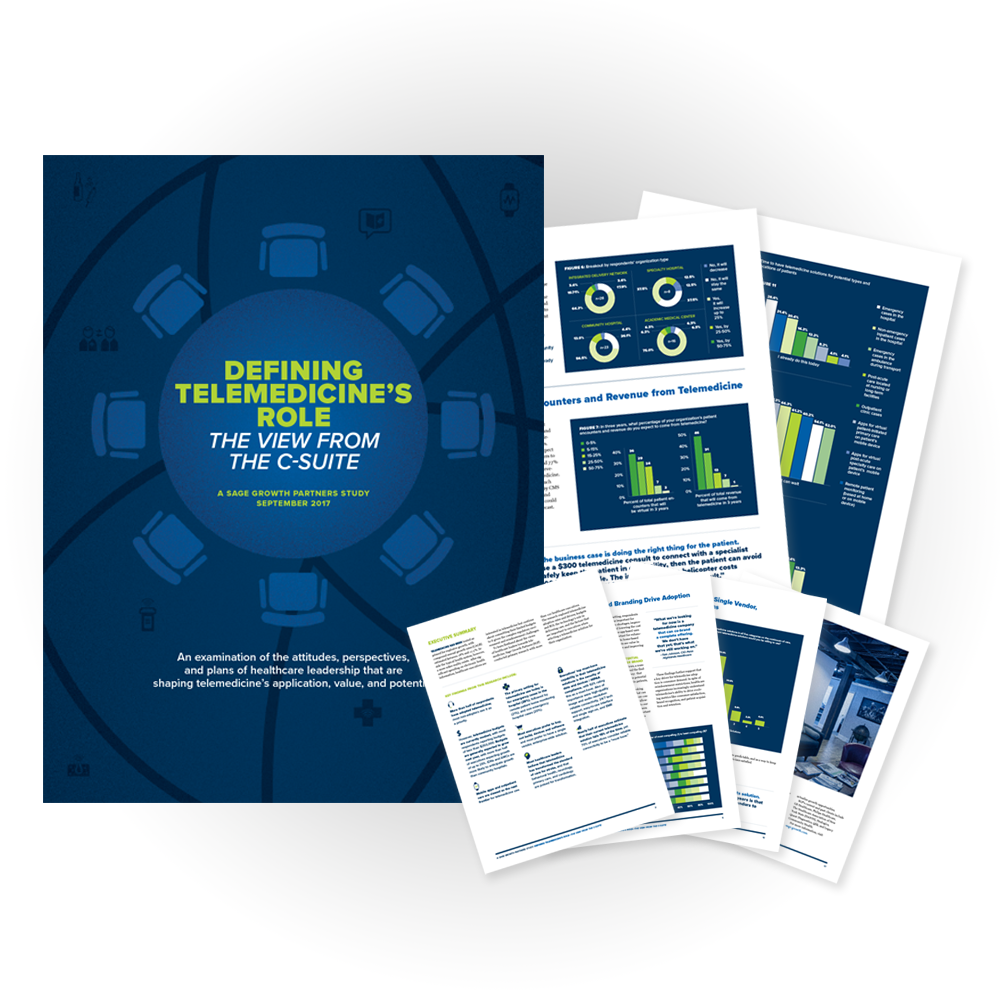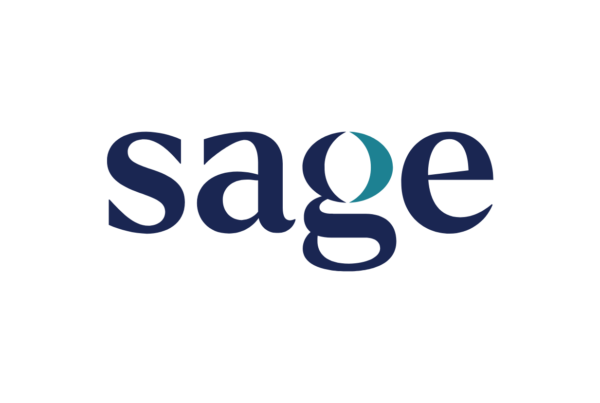New Sage Growth Partners survey reveals that 44% percent of healthcare organizations have not yet adopted telemedicine; however 86% say it is a priority
Baltimore, MD – February 12, 2018 – Sage Growth Partners (SGP), a Baltimore-based healthcare research, strategy, and marketing firm, today released new survey findings that explore healthcare executives’ application and adoption of telemedicine technology. SGP’s report, Defining Telemedicine’s Role: The View From the C-Suite, details findings from its survey of nearly 100 healthcare executives1 alongside additional quantitative and qualitative research.
The findings reveal healthcare executives’ attitudes towards telemedicine, current and expected future use, and opportunities for return on investment. Access the full research report here.
Key survey findings include:
MORE THAN HALF HAVE ADOPTED TELEMEDICINE; MOST NON-ADOPTERS SEE IT AS A PRIORITY
- Fifty-six percent have already implemented telemedicine in their organization; 27% have built or are building their own solution, while 29% are already working with one or more vendors.
- Forty-four percent have not yet adopted telemedicine; 24% are actively seeking telemedicine solutions, while 20% are just beginning to learn about what is out there.
- Of those who have not yet adopted telemedicine, 86% say it is a medium to high priority.
TELEMEDICINE BUDGETS ARE MODEST BUT GROWING
Of those who have telemedicine solutions in their facilities today:
- Two-thirds (66%) have telemedicine budgets of $250,000 or less, while a quarter (25%) have budgets of $250,000-$1 million. Only nine percent have budgets of more than $1 million.
- Nearly three-quarters of respondents expect their telemedicine budget to increase next year; 59% expect it to increase by up to 25%, and 14% expect it to increase by more than 25%.
- Twenty-six percent of respondents expect their budget to stay the same, and only two percent expect it to decrease.
BEHAVIORAL HEALTH AND OTHER SPECIALTIES ARE POISED FOR TRANSFORMATION
- Three-quarters (75%) of respondents believe telemedicine has the potential to transform the standard of care for behavioral health/psychiatry, and approximately half believe it will transform care in neurology (53%), primary care (52%), and cardiology (48%).
- Seventy percent believe that telemedicine has already transformed the standard of care for stroke.
MOBILE APPS AND OUTPATIENT CARE ARE THE NEXT FRONTIER FOR TELEMEDICINE USE
- The No. 1 setting for telemedicine use today is for emergency cases in the hospital (29%), followed by remote patient home monitoring (21%), and non-emergency hospital cases (20%).
- Though only four percent currently use telemedicine for post-acute specialty care, the large majority (75%) are interested in applying a telemedicine solution there in the future.
- Using telemedicine in outpatient clinics (69%) and for virtual primary care on the patient’s mobile device (68%) come in second and third on respondents’ wish lists.
- Executives are least interested in using telemedicine for emergency cases in the ambulance during transport (36% say they don’t want or need it).
Fig. 1. Current and future telemedicine adoption by setting
| I already do this today | I want it eventually | I do not want or need it | Respondent total | |
| Emergency cases in the hospital | 29% | 54% | 17% | 100% |
| Non-emergency cases in the hospital | 20% | 67% | 13% | 100% |
| Emergency cases in the ambulance during transport | 12% | 52% | 36% | 100% |
| Post-acute care in the facility | 4% | 61% | 35% | 100% |
| Outpatient clinic | 14% | 69% | 17% | 100% |
| Apps for virtual patient-initiated primary care on the patient’s mobile device | 8% | 68% | 24% | 100% |
| Apps for virtual post-acute specialty care on patient’s mobile device | 4% | 75% | 21% | 100% |
| Remote patient monitoring | 21% | 60% | 18% | 100%
|
POSITIVE NEAR-TERM ROI IS MOST FREQUENTLY ASSOCIATED WITH OUTPATIENT CLINIC AND HOSPITAL SETTINGS
- The majority of respondents see positive ROI within three years in the outpatient clinic (75%), non-emergency hospital care (72%), emergency hospital care (71%), remote patient monitoring (68%), apps for virtual post-acute specialty care (63%), apps for virtual patient-initiated primary care on the patient’s mobile device (62%), and post-acute care in the facility (62%).
- Less than half (46%) believe there will be positive ROI for emergency cases in the ambulance during transport.
TELEMEDICINE WILL SUPPLEMENT, BUT NOT REPLACE, CURRENT CARE DELIVERY METHODS
- Only nine percent of respondents believe that a quarter or more of their patient encounters will be virtual in three years. Thirty-seven percent believe up to five percent of encounters will be virtual, almost a third (30%) expect telemedicine to make up between 5-15% of encounters, and a quarter expect it to make up 15-25% of encounters.
- The vast majority (79%) believe telemedicine will contribute to less than 15% of their total revenue in three years. Thirteen percent believe it will make up 15-25%, and eight percent believe it could make up as much as 25-75% of revenue.
MUST-HAVE CAPABILITIES INCLUDE SECURITY, QUALITY AUDIO AND VIDEO, AND RELIABLE CONNECTIVITY
- Executives’ top must-have capability is the security of data and devices / HIPAA compliance (92%). This is followed by high-quality image and audio resolution (74%), reliable connectivity (70%), 24/7 tech support (70%), easy-to-use interface and single sign-on (69%), and EMR integration (67%).
- They view the least essential capabilities as smartphone apps for patient-initiated consults (19% don’t want or need), assistance with provider shortages (16%), and clinical and operational workflow (8%).
- Although 70% of executives consider reliable connectivity to be a “must have,” nearly half (46%) estimate that their current telemedicine solution fails at least 15% of the time.
“There has been an incredible amount of hype around telemedicine,” said Dan D’Orazio, SGP CEO. “Our survey reveals that, despite its potential to transform many critical areas of care, more than two in five organizations have not yet adopted telemedicine. And for those hospitals and health systems that have made the leap, their budgets are still modest. Reimbursement and regulatory issues have been a huge factor in slowing the adoption of telemedicine, but a lot can change, and quickly — having CMS increase its reimbursement for telehealth would significantly accelerate its implementation. The value that telemedicine can deliver is clear to healthcare executives, but they must see a return on investment before they will increase their investments from modest to meaningful.”
Download the report here.
1 Methodology
Conducted in May 2017, the in-depth online survey received 98 respondents. Nearly two thirds (59%) were C-suite executives, and 41% were service line leaders or department chiefs. Respondents represented integrated delivery networks (30%), community hospitals (30%), specialty hospitals (25%), and academic medical centers (16%).
ABOUT SAGE GROWTH PARTNERS
Sage Growth Partners accelerates commercial success for healthcare organizations through a singular focus on growth. The company helps its clients thrive amid the complexities of a rapidly changing marketplace with deep domain expertise and an integrated application of research, strategy, and marketing.
Founded in 2005, Sage Growth Partners is located in Baltimore, MD and serves clients such as Philips Healthcare, Quest Diagnostics, Launchpoint, Ingenious Med, and ArborMetrix. Visit us online at www.sage-growth.com.





